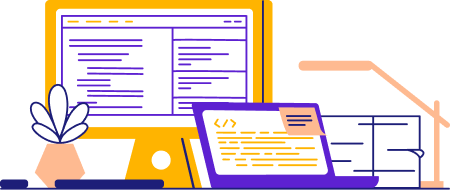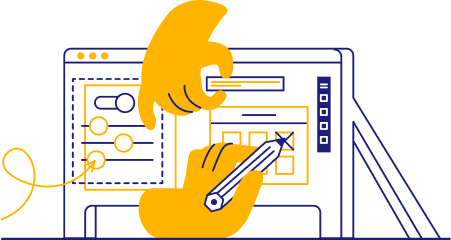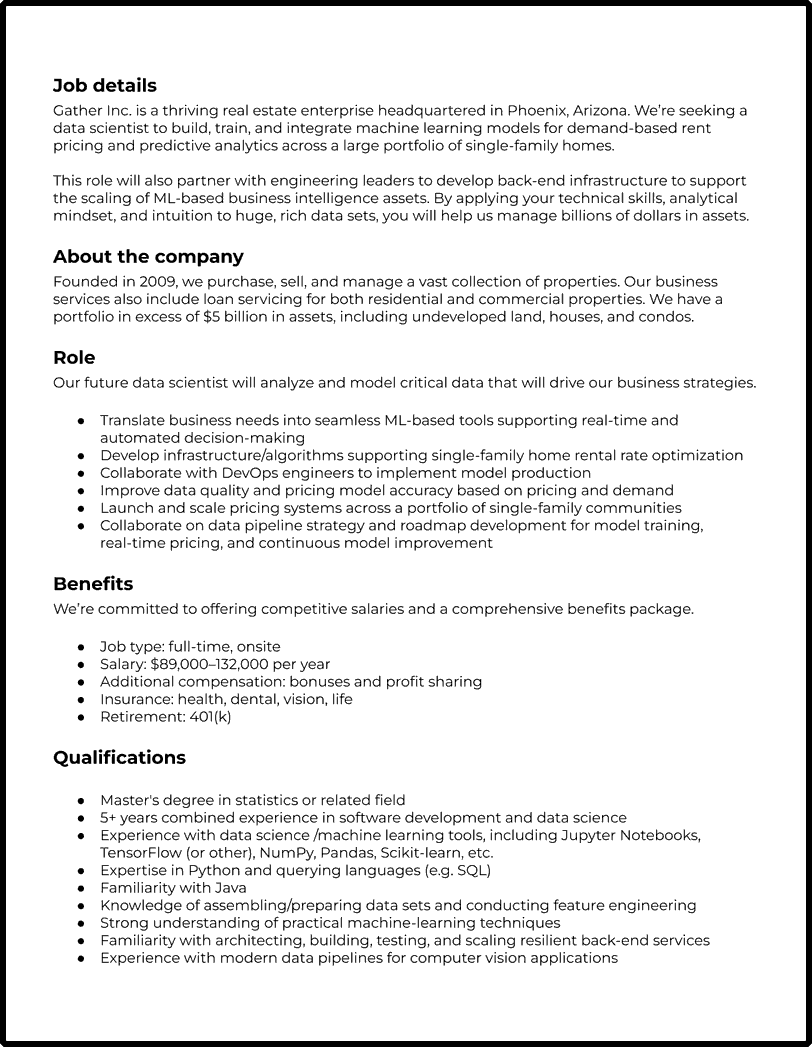The profession of data science is continuing to grow and is a very in-demand role. Data scientists typically work for corporations across all industries to provide meaningful insights about how to improve business operations.
Finding and hiring an exceptional data scientist for your company or organization can be a time-consuming and arduous process. But we’ll give you some great examples and expert guidance to help create the best data scientist job description that will attract the most suitable candidates for you.
Write an Effective Data Scientist Job Description

Crafting an effective and well-written job description is not always easy. A data scientist role is especially difficult because it is a highly technical role that encompasses a broad range of skills and varies greatly from company to company. The biggest challenge you will have is keeping it from being too lengthy and staying focused on the most important things your data scientist needs to know and what they will need to do.
Condense your job description down to the vital information
A data scientist must perform many complex tasks simultaneously. They are required to assess large amounts of data, quickly and efficiently identify essential data, and distill it down to the most valuable information. Likewise, your job description must be distilled to the essentials—nothing more.
Ensuring your potential candidates will read the entire job description is a major objective you must keep in mind as you write. The most essential thing you need to do is keep your job description brief and concise. Listing all the pertinent job requirements for a data scientist role without creating a lengthy document can be difficult, but make a concerted effort to include the key info and “kill your darlings” by eliminating the unnecessary.
Another major objective to remember is that you’re selling the job and your organization. You are trying to attract as many qualified applicants as possible. The best way to demonstrate what a job entails is by giving examples of issues a data scientist in your company will face. For instance,
- Provide particulars of a problem they’ll need to fix (developing custom data models and algorithms to apply to data sets),
- Discuss a gap they’ll fill (improvements to data quality and pricing model accuracy), or
- State why you’re specifically hiring for the role (to institute a data science center of excellence).
Returning full circle, George Mason University’s writing center stresses the importance of condensing your writing. According to the experts, writing concisely means that you “write what you mean—nothing more and nothing less.” When you create a data scientist job description, consider each word choice and look for extra words you can remove without changing the meaning. Remove filler words and extraneous language.
Write to encourage diverse candidates
Focus your requirements on the critical and unique needs of your company, eliminating common data science skills or traits, such as “strong data analysis skills.” This fluff clogs up your job description, not to mention that listing too many requirements tends to discourage diverse candidates from applying, especially in STEM.
Writing a completely unbiased data scientist job description isn’t always easy despite your best efforts. It takes a conscious effort to use words and phrases that will encourage diverse populations to apply. MIT’s “Ensuring Bias-Free Job Postings” gives a high-level overview of the issue and has some pointers to help you avoid pitfalls that incidentally stereotype or alienate job seekers.
Edit and revise for content and grammar
The final and most important step to creating a great job description is editing and revising. Invite people in the data science function to review your work as any additional review is beneficial. Seek out constructive criticism, and be willing to make changes if appropriate.
The worst thing you can do is submit a job description that has poor word choice, grammatical errors, or even worse, an inaccurate salary range with one too many zeros. Take your time, and when you’re done, you can be confident that you’ve published a high-quality listing that will attract the best talent for your data scientist role.
Start by Framing Your Data Scientist Job Description

We’ve shown you the examples and stressed the importance of writing your job description well, but we get that those things can seem a bit arbitrary when you’re staring at a blinking cursor on a blank screen.
Check out the following outline that covers all the sections for any data scientist job description; then, all you need to do is fill it in, drawing upon inspiration from the examples and how-to guide above.

Job details
This section is where you briefly introduce the company and the open position. You should leverage this section to immediately grab the reader’s attention. Offer candidates a taste of why your company is a great place to work. Then, in a couple of sentences, give them a quick blurb on the what and why of your data scientist role to encourage job seekers to read the rest of your job description.

About the company
This section of your job description should contain additional information about your company. A data scientist will be interested in knowing a company’s strategy regarding data analysis, the usage of big data, and how the company leverages information technology. Cover these items, or anything directly related, in a sentence or two, noting the role of the data scientist.

What you’ll be doing
You may also call this section the “Roles” or “Responsibilities” or “Requirements.” This section should be a bulleted list of the key tasks performed in the job role. Don’t make it too long. Ensure you include anything unique to or especially cool about the data scientist role in your company. Emphasize anything critical to the success of the position. As with any business writing, always use active verbs, avoid jargon and filler words, and be as specific as possible.
- Collect data from established channels and through means such as analyzing business results or the creation of new studies.
- Create new, experimental frameworks to collect data, and build tools to automate data collection.
- Carry out preprocessing (structured and unstructured data) cleansing, and validating the integrity of data to be used for analysis.
- Mine and analyze data from company databases to drive optimization and improvement of product development, marketing techniques, and business strategies.
- Correlate similar data to find actionable information and present results concisely.

Qualifications
This section is the make-or-break section. It quickly tells candidates whether they are a good fit for the job. Craft this section carefully. Always include anything critical and must-haves for the position. A good job description will list education, experience level, certifications, and any special requirements.
Technical qualifications should always be described as specifically and objectively as possible. Consider whether you need to include soft skills at all. Perhaps you can discern that in an applicant’s data scientist resume or data scientist cover letter, saving room to list job-specific qualifications, such as text classification topic mining or speech enhancement.
As you know, data science can include a lot of very technical requirements. Focus on the job’s critical aspects, but avoid having too long a list. If your company has a lot of unique or extraordinary requirements, then use most of this section to cover that. As with every part of your job description, be brief, specific, and clear.
- Master’s or Ph.D. in statistics, mathematics, computer science, artificial intelligence, machine learning, or another quantitative field
- 5+ years of professional experience as a data scientist or in a related role
- 3+ years of work experience in voice-related projects
- 3+ years of work experience in software development
- Experience establishing supervised and unsupervised learning Client/NLP models, including data cleaning, data analytics, feature creation, model selection and ensemble methods, performance metrics, and visualization
- Knowledgeable of signal processing techniques, including adaptive filtering, filter banks and wavelet processing, speech analysis, and synthesis, and speech and audio coding
- Expertise in text classification topic mining, speech enhancement, and speech/audio coding and compression

Nice-to-have
If you have a lot of other skills that you are looking for, but they are not deal-breakers, then you may include these as a subsection to your qualifications. List all the things you consider to be key differentiators for candidates. Again, try not to list too many because this will discourage some candidates.

Benefits
The benefits section is a brief but standard item to include in your job description. Where you place it in the overall format is not so important, though it shouldn’t be the first item. If your company has outstanding benefits and/or something extraordinary to offer, such as an onsite gym or an unlimited vacation policy, then you may want to place this section earlier to snag the reader’s attention.
On the Job: The Responsibilities of Data Scientists

Data scientists are researchers and masters of quantitative analysis. They investigate extremely large volumes of data and solve business challenges using data. Advanced data science involves identifying relevant data, detecting patterns and trends, and translating them into viable business plans and strategies. A data scientist must rapidly process and transform large data sets into understandable and usable business information.
Below are some sample roles a data science professional might fulfill. A single scientist may not fulfill all these roles, but this will give you are good list to choose from and add to based on your company’s specific needs.

Data acquisition
- The foundation of data science is investigating data. Having an inquisitive nature allows a data scientist to objectively review large databases and data sets from many sources, extract pertinent information, and solve an issue or answer a particular question.
- Ask the right questions to drive the discovery process in the right direction.
- Perform initial data investigation and exploratory data analysis.
- Examine internal and external sources of data and detect important patterns and trends.
- Determine processing methodologies to best transform data into usable business intelligence.
- Think critically about how data is used, and assess and quantify strengths, weaknesses, and opportunities posed by data sources and processing.
- Continually seek new data sources, ways to improve data processing, and new technologies to better utilize data.

Problem solving
- A data scientist defines how data can be used to make the organization successful. They provide expertise and guidance to the business on how to interpret information to formulate successful processes and business strategies.
- Study business challenges, research relevant data processing techniques, and determine solutions through data analysis.
- Apply data science techniques, such as machine learning, statistical modeling, and artificial intelligence.
- Process and clean data to create useful databases and information.
- Effectively integrate and store data into databases and business intelligence systems.
- Identify problems in data acquisition, processing, and utilization; then, assess and resolve them.
- Continually partner with business and data analysts to review data processing and make recommendations for improvements.

Communication and reporting
- A great data scientist must have excellent written and verbal communication skills. They are required to present and explain highly technical, complex information, and recommendations to all levels within the organization.
- Partner with technical and data analysis teams to understand business processes and data sets to create documentation and presentations that translate data into coherent business information.
- Present high-level results and recommendations to executive-level stakeholders.
- Assess business feedback and make appropriate adjustments to data processing and analysis procedures.
- Facilitate business communication and reporting for internal and external stakeholders.

Leadership
- Data science is typically an upper and executive management level position. Management experience and strong leadership skills are non-negotiable. They should have a background in leading data analysis teams, have general management experience, and have proven abilities to collaborate with executives.
- Provide direct expertise and leadership to business owners on the analysis and understanding of data utilization in business processes.
- Consult with and provide direction to stakeholders (internal and external) regarding best practices and effective data use to improve business processes.
- Lead teams, organizations, and programs to productively leverage data gathering and analysis to successfully complete tasks, initiatives, and projects.

Training
- Data science is an ever-evolving field. Any good data scientist should have a strong interest in continued education and seek learning opportunities related to data science, statistics, and data analytics to improve their professional capabilities. They should not only be driven to improve their own knowledge but should also be strong proponents for organizational learning and training.
- Research and stay abreast of the current state of data science.
- Consistently spend time studying, completing professional training, and maintaining all certifications.
- Engage with business units and regularly assess how they are utilizing data, information, and reporting tools to ensure that business strategies and objectives are achieved.
- Spearhead ongoing training and technical education for data analysis professionals and business process owners to enhance and evolve the organization’s data analysis capabilities.






